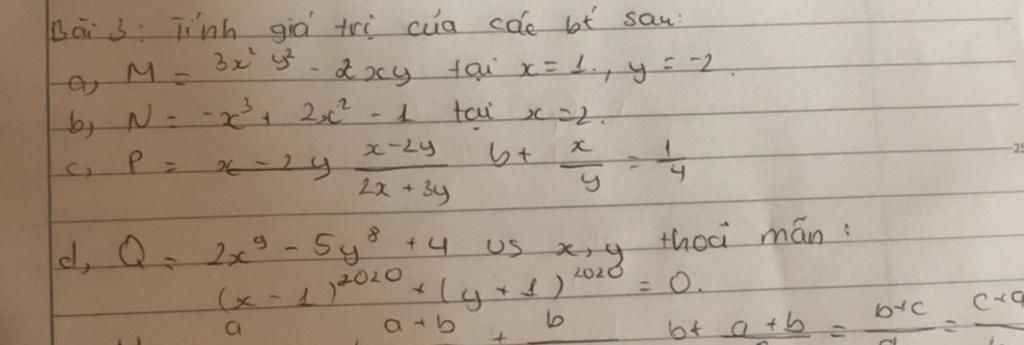Bài 10. Cho biểu thức : a ^ 2 = b ^ 5 - b ^ 4.c . Trong 3 số a, b, c có một số dương, một số âm và một số bằng 0. Hãy chỉ rõ số dương, số âm và số 0
Hãy nhập câu hỏi của bạn vào đây, nếu là tài khoản VIP, bạn sẽ được ưu tiên trả lời.


`@` `\text {Ans}`
`\downarrow`
`P(x)=x^4 + 3x^2 + 13 = 0`
Vì \(\left\{{}\begin{matrix}x^4\ge0\text{ }\forall\text{ x}\\x^2\ge0\text{ }\forall\text{ x}\end{matrix}\right.\)
`=>`\(\left\{{}\begin{matrix}x^4\ge0\text{ }\forall\text{ x}\\3x^2\ge0\text{ }\forall\text{ x}\end{matrix}\right.\)
`=>`\(x^4+3x^2+13\ge13>0\text{ }\forall\text{ x}\)
Mà 13 \ne 0`
`=>` Đa thức `P(x)` vô nghiệm.
P(x) = x⁴ + 2 . x² . 3/2 + (3/2)² + 13 - (3/2)²
= (x² + 3/2)² + 43/4
Do (x² + 3/2)² ≥ 0 với mọi x
⇒ (x² + 3/2)² + 43/4 > 0 với mọi x
Vậy P(x) vô nghiệm

\(a,M\left(x\right)=P\left(x\right)+Q\left(x\right)=x^2+2x-5+x^2-9x+5\)
\(=2x^2-7x\)
\(N\left(x\right)=P\left(x\right)-Q\left(x\right)=\left(x^2+2x-5\right)-\left(x^2-9x+5\right)\)
\(=x^2+2x-5-x^2+9x-5\)
\(=11x-10\)
\(b,\) Đặt \(M\left(x\right)=0\Rightarrow2x^2-7x=0\)
\(\Rightarrow x\left(2x-7\right)=0\)
\(\Rightarrow\left[{}\begin{matrix}x=0\\2x-7=0\end{matrix}\right.\)
\(\Rightarrow\left[{}\begin{matrix}x=0\\x=\dfrac{7}{2}\end{matrix}\right.\)
Vậy \(M\left(x\right)\) có nghiệm là \(x=0,x=\dfrac{7}{2}\)
Đặt \(N\left(x\right)=0\Rightarrow11x-10=0\Rightarrow x=\dfrac{10}{11}\)
Vậy \(N\left(x\right)\) có nghiệm là \(x=\dfrac{10}{11}\)
a) Ta có: \(M\left(x\right)=P\left(x\right)+Q\left(x\right)\)
\(\Rightarrow M\left(x\right)=\left(x^2+2x-5\right)+\left(x^2-9x+5\right)\)
\(M\left(x\right)=x^2+2x-5+x^2-9x+5\)
\(M\left(x\right)=2x^2-7x\)
Ta có: \(N\left(x\right)=P\left(x\right)-Q\left(x\right)\)
\(\Rightarrow N\left(x\right)=\left(x^2+2x-5\right)-\left(x^2-9x+5\right)\)
\(N\left(x\right)=x^2+2x-5-x^2+9x-5\)
\(N\left(x\right)=11x-10\)
b) Ta có:
\(M\left(x\right)=2x^2-7x=0\)
\(\Leftrightarrow2x^2-7x=0\)
\(\Leftrightarrow x\left(2x-7\right)=0\)
\(\Leftrightarrow\left[{}\begin{matrix}x=0\\2x-7=0\end{matrix}\right.\)
\(\Leftrightarrow\left[{}\begin{matrix}x=0\\x=\dfrac{7}{2}\end{matrix}\right.\)
Ta có: \(N\left(x\right)=11x-10=0\)
\(\Leftrightarrow11x-10=0\)
\(\Leftrightarrow11x=10\)
\(\Leftrightarrow x=\dfrac{10}{11}\)

`@` `\text {Ans}`
`\downarrow`
\(\dfrac{x-3}{3}=\dfrac{2x+1}{5}\)
`=> (x-3)5 = (2x+1)3`
`=> 5x-15 = 6x+3`
`=> 5x-6x = 15+3`
`=> -x=18`
`=> x=-18`
\(\dfrac{x+1}{22}=\dfrac{6}{x}\)
`=> (x+1)x = 22*6`
`=> (x+1)x = 132`
`=> x^2 + x = 132`
`=> x^2+x-132=0`
`=> (x-11)(x+12)=0`
`=>`\(\left[{}\begin{matrix}x-11=0\\x+12=0\end{matrix}\right.\)
`=>`\(\left[{}\begin{matrix}x=11\\x=-12\end{matrix}\right.\)
\(\dfrac{2x-1}{2}=\dfrac{5}{x}\)
`=> (2x-1)x = 2*5`
`=> 2x^2 - x =10`
`=> 2x^2 - x - 10 =0`
`=> 2x^2 + 4x - 5x - 10 =0`
`=> (2x^2 + 4x) - (5x+10)=0`
`=> 2x(x+2) - 5(x+2)=0`
`=> (2x-5)(x+2)=0`
`=>`\(\left[{}\begin{matrix}2x-5=0\\x+2=0\end{matrix}\right.\)
`=>`\(\left[{}\begin{matrix}2x=5\\x=-2\end{matrix}\right.\)
`=>`\(\left[{}\begin{matrix}x=\dfrac{5}{2}\\x=-2\end{matrix}\right.\)
\(\dfrac{2x-1}{21}=\dfrac{3}{2x+1}\)
`=> (2x-1)(2x+1)=21*3`
`=> 4x^2 + 2x - 2x - 1 = 63`
`=> 4x^2 - 1=63`
`=> 4x^2 - 1 - 63=0`
`=> 4x^2 - 64 = 0`
`=> 4(x^2 - 16)=0`
`=> 4(x^2 + 4x - 4x - 16)=0`
`=> 4[(x^2+4x)-(4x+16)]=0`
`=> 4[x(x+4)-4(x+4)]=0`
`=> 4(x-4)(x+4)=0`
`=>`\(\left[{}\begin{matrix}x-4=0\\x+4=0\end{matrix}\right.\)
`=>`\(\left[{}\begin{matrix}x=4\\x=-4\end{matrix}\right.\)
\(\dfrac{2x+1}{9}=\dfrac{5}{x+1}\)
`=> (2x+1)(x+1) = 9*5`
`=> (2x+1)(x+1)=45`
`=> 2x^2 + 2x + x + 1 = 45`
`=> 2x^2 + 3x + 1 =45`
`=> 2x^2 + 3x + 1 - 45 =0`
`=> 2x^2+3x-44=0`
`=> 2x^2 + 11x - 8x - 44=0`
`=> (2x^2 +11x) - (8x+44)=0`
`=> x(2x+11) - 4(2x+11)=0`
`=> (x-4)(2x+11)=0`
`=>`\(\left[{}\begin{matrix}x-4=0\\2x+11=0\end{matrix}\right.\)
`=>`\(\left[{}\begin{matrix}x=4\\2x=-11\end{matrix}\right.\)
`=>`\(\left[{}\begin{matrix}x=4\\x=-\dfrac{11}{2}\end{matrix}\right.\)
\(\dfrac{x-3}{3}=\dfrac{2x+1}{5}\\ \left(x-3\right)\cdot5=\left(2x+1\right)\cdot3\\ x5-15=6x+3\\ x5-6x=3+15\\ -x=18\\ \Rightarrow x=-18\)
\(\dfrac{x+1}{22}=\dfrac{6}{x}\\ \left(x+1\right)\cdot x=6\cdot22\\ \left(x+1\right)\cdot x=2\cdot3\cdot2\cdot11\\ \left(x+1\right)\cdot x=12\cdot11\\ \Rightarrow x=11\)
\(\dfrac{2x-1}{21}=\dfrac{3}{2x+1}\\ \left(2x-1\right)\cdot\left(2x+1\right)=21\cdot3\\ \left(2x-1\right)\cdot\left(2x+1\right)=7\cdot3\cdot3\\ \left(2x-1\right)\cdot\left(2x+1\right)=7\cdot9\\ \Rightarrow2x+1=9\\ 2x=8\\ x=4\)

P(\(x\)) = \(x^4\) + 3\(x^2\) - 4033
P(\(x\)) = \(x^4\) + 2.\(\dfrac{3}{2}\)\(x^2\) + \(\dfrac{9}{4}\) - \(\dfrac{16141}{4}\)
P(\(x\)) = (\(x^2\) + \(\dfrac{3}{2}\))2 - \(\dfrac{16141}{4}\)
P(\(x\)) = 0 ⇔ (\(x^2\) + \(\dfrac{3}{2}\))2 - \(\dfrac{16141}{4}\) = 0
⇒ (\(x^2\) + \(\dfrac{3}{2}\))2 = \(\dfrac{16141}{4}\)
\(x^2\) + \(\dfrac{3}{2}\) = - \(\sqrt{\dfrac{16141}{4}}\) (loại)
\(x^2\) + \(\dfrac{3}{2}\) = \(\sqrt{\dfrac{16141}{4}}\)
\(x^2\) = \(\sqrt{\dfrac{16141}{4}}\) - \(\dfrac{3}{2}\) > 0
\(x\) = \(\mp\) \(\sqrt{\sqrt{\dfrac{16141}{4}}-\dfrac{3}{2}}\)
Vậy việc chứng minh: P(\(x\)) vô nghiệm là không xảy ra

a) \(\dfrac{7}{4}< \dfrac{a}{8}< 3\\ =>\dfrac{7}{4}.8< a< 3.8\\ =>14< a< 24\\ =>a\in\left\{15;16;17;...;23\right\}\)
b) \(\dfrac{2}{3}< \dfrac{a-1}{6}< \dfrac{8}{9}\\ =>\dfrac{2}{3}.6< a-1< \dfrac{8}{9}.6\\ =>4< a-1< \dfrac{16}{3}\\ =>4+1< a< \dfrac{16}{3}+1\\ =>5< a< \dfrac{19}{3}\\ =>a=6\)
b) \(\dfrac{2}{3}< a-\dfrac{1}{6}< \dfrac{8}{9}\\ =>\dfrac{2}{3}+\dfrac{1}{6}< a< \dfrac{8}{9}+\dfrac{1}{6}\\ =>\dfrac{5}{6}< a< \dfrac{19}{18}\\ =>a=1\)
c) \(\dfrac{12}{9}< \dfrac{4}{a}< \dfrac{8}{3}\\ =>\dfrac{24}{18}< \dfrac{24}{6a}< \dfrac{24}{9}\\ =>9< 6a< 18\\ =>\dfrac{9}{6}< a< \dfrac{18}{6}\\ =>1,5< a< 3\\ =>a=2\)

`@` `\text {Ans}`
`\downarrow`
Ta có: \(\dfrac{x-1}{2}=\dfrac{y+3}{4}=\dfrac{z-5}{6}\)
\(\Rightarrow\dfrac{3x-3}{6}=\dfrac{4y+12}{16}=\dfrac{5z-25}{30}\)
Áp dụng tính chất dãy tỉ số bằng nhau ta có:
\(\dfrac{3x-3}{6}=\dfrac{4y+12}{16}=\dfrac{5z-25}{30}\)`=`\(\dfrac{\left(5z-25\right)-\left(3x-3\right)-\left(4y+12\right)}{30-6-16}\)
`=`\(\dfrac{5z-25-3x+3-4y-12}{8}\)
`=`\(\dfrac{\left(5z-3x-4y\right)+\left(-25+3-12\right)}{8}\)
`=`\(\dfrac{50-34}{8}\)`=`\(\dfrac{16}{8}=2\)
`=>`\(\dfrac{x-1}{2}=\dfrac{y+3}{4}=\dfrac{z-5}{6}=2\)
`=>`\(\left\{{}\begin{matrix}x=2\cdot2+1=5\\y=2\cdot4-3=5\\z=2\cdot6+5=17\end{matrix}\right.\)
Vậy, `x,y,z` lần lượt là `5; 5; 17.`


Bài 3: Tính giá trị của
a, M = 3\(x^2\)y2 - 2\(xy\) - 1 tại \(x\) = 1; \(y\) = -2
Thay \(x\) = 1; \(y\) = -2 vào biểu thức M = 3\(x^2\)y2 - 2\(xy\) - 1 ta có:
M = 3.(1)2.(-2)2 - 2.(1)2.(-2) = 12 + 4 = 16
b, N = -\(x\)3 + 2\(x\)2 - 1 tại \(x\) = 2
Thay \(x\) = 2 vào biểu thức N = - \(x^3\) + 2\(x^2\) - 1 ta có:
N = -(2)3 +2.(2)2 - 1 = -1
c, Không rõ tại \(x\) = ?; \(y\) = ?
d, Q = 2\(x^9\) - 5\(y\)8 + 4 và \(x;y\) thỏa mãn (\(x-1\))2020 +(\(y\) +1)2020
Ta có: \(\left\{{}\begin{matrix}\left(x-1\right)^{2020}\ge0\forall x\\\left(y+1\right)^{2020}\ge0\forall x\end{matrix}\right.\)
⇒ (\(x-1\))2020+(y+1)2020 = 0
⇔ \(\left\{{}\begin{matrix}x-1=0\\y+1=0\end{matrix}\right.\) ⇔ \(\left\{{}\begin{matrix}x=1\\y=-1\end{matrix}\right.\)
Thay \(\left\{{}\begin{matrix}x=1\\y=-1\end{matrix}\right.\) vào biểu thức:
Q = 2\(x^9\) - 5\(y^8\) + 4 ta có:
Q = 2.(1)9 - 5.(-1)8 + 4 = 2 - 5 + 4 = 1

Với x ≥ 0 thì \(\sqrt{x}\ge0\) nên \(\sqrt{x}+1\ge1\)
Khi đó \(B=\left(\sqrt{x}+1\right)^{99}+2022\ge1^{99}+2022\)
Hay \(B=\left(\sqrt{x}+1\right)^{99}+2022\ge2023\)
Dấu "=" xảy ra khi \(\sqrt{x}=0\) hay x = 0
Vậy GTNN của \(B=\left(\sqrt{x}+1\right)^{99}+2022\) là 2023 khi x = 0
\(B=\left(\sqrt{x}+1\right)^{99}+2022\left(x\ge0\right)\)
Vì: \(x\ge0\)
Nên => \(\left(\sqrt{x}+1\right)^{99}\ge0\)
=> \(\left(\sqrt{x}+1\right)^{99}+2022\ge2022\)
=> \(B\ge2022\)
Dấu " = " xảy ra khi: \(\Leftrightarrow\sqrt{x}+1=0\Leftrightarrow\sqrt{x}=-1\left(voli\right)\)
Vậy: B không có giá trị nhỏ nhất

TH1: a là dương; b là số âm; c là 0
Ta có: \(a^2>0\)
\(\Rightarrow b^5-b^4c=b^5-b^4.0=b^5-0=b^5>0\)
\(\Rightarrow a^2=b^5\) (vô lí)
TH2: a là 1 số âm, b là số dương, c là số 0
Ta có: \(a^2>0\)
\(\Rightarrow b^5-b^4c=b^5>0\)
\(\Rightarrow a^2=b^5\) (thỏa mãn)
Vậy trong 3 số a là số âm, b là số dương, c là số 0
cc